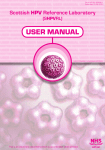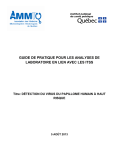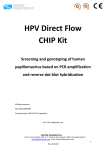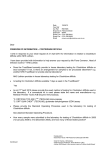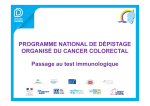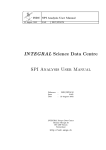Download USER MANUAL - NHS Lothian Laboratory Medicine
Transcript
PD-MOL-R-USERHBK_HPV Version 3 Issue date: 19/06/12 Review date: 19/06/14 Scottish HPV Reference Laboratory (SHPVRL) USER MANUAL Author: K Cuschieri & C Moore This is an electronic document which is uncontrolled when printed. CONTENTS PD-MOL-R-USERHBK_HPV Version 3 Issue date: 19/06/12 Review date: 19/06/14 Glossary Page 2 Purpose Page 3 Scope of service Page 3 Contact details & hours of work Page 4 HPV tests offered Page 5 Submission of specimens Page 7 HPV types detected with different HPV tests Page 9 Factors affecting performance of HPV test Page 10 Additional tests Page 11 Definition of “high-risk” and “low-risk” HPV types Page 12 Reporting of results Page 15 Laboratory accreditation Page 15 External quality assurance schemes Page 15 SHPVRL and research and development Page 16 Selected publications Page 17 Appendix 1 Page 19 Appendix 2 Page 20 Appendix 3 Page 21 Page 1 of 24 Author: K Cuschieri & C Moore PD-MOL-R-USERHBK_HPV Version 3 Issue date: 19/06/12 Review date: 19/06/14 GLOSSARY HPV Human Papillomavirus HPS Health Protection Scotland LBC Liquid Based Cytology SCSP Scottish Cervical Screening Programme ECOSS Electronic Communication of Surveillance in Scotland NATS Nucleic Acid tests SCCRS Scottish Cervical Call Recall System FFPE Formalin Fixed Paraffin Embedded NEQAS National External Quality Assurance Scheme QCMD Quality Control in Molecular Diagnostics FDA CE IARC PV Food and Drug Administration Certificate European International Agency of Research on Cancer Papillomavirus Page 2 of 24 Author: K Cuschieri & C Moore PD-MOL-R-USERHBK_HPV Version 3 Issue date: 19/06/12 Review date: 19/06/14 1. PURPOSE The Scottish Human Papillomavirus Reference Laboratory (SHPVRL) is commissioned by Health Protection Scotland (HPS) to provide a comprehensive service for screening and typing of Human Papillomavirus (HPV). 2. SCOPE OF SERVICE • To provide testing services to evaluate the impact of the HPV immunisation programme on the incidence and prevalence of HPV related disease and HPV infection in the Scottish population. • To provide a specialist diagnostic and expert advice service in relation to HPV for specific clinical cases where it could help inform clinical management. • To provide education and training for the wider service and develop and validate new HPV technologies; carry out quality control and external quality assurance and act as a base for research and development. • To contribute to the data and knowledge of changing epidemiology of HPV associated disease to help inform the future organisation of services to prevent cervical disease and cancer. Other elements HPV testing for the Scottish Cervical Screening Programme (SCSP) SHPVRL also provides information, advice and testing services for the Scottish Cervical Screening Programme (SCSP). To this end, SHPVRL currently performs HPV testing as a “test of cure” of treatment. Following an early implementation phase across part of Scotland, test of cure was rolled out from the 30th April in 2012. Standard Operating Procedures for the delivery of HPV testing services for test of cure service have been developed between SHVPRL and the Scottish Cytology Laboratories. For further information on this service please contact SHPVRL (page 4). SHPVRL collaborates with partners including UK NEQAS and the English Cervical Screening Programme in the preparation of material for HPV quality assurance and validation schemes. Page 3 of 24 Author: K Cuschieri & C Moore PD-MOL-R-USERHBK_HPV Version 3 Issue date: 19/06/12 Review date: 19/06/14 3. CONTACT DETAILS AND HOURS OF WORK Please contact Dr Kate Cuschieri for advice on HPV testing. For administration purposes please contact Mrs Evelyn Wallace. Name and Designation Director Dr Kate Cuschieri Medical Consultant Dr Ingo Johannessen Advanced Biomedical Scientist Mrs Catherine Moore Specialist Biomedical Scientist Miss Alison Fleming Associate Clinical Scientist Dr Christopher Ward Biomedical Support Worker Mr Norman Stenhouse Telephone numbers and Email address 0131 242 6039 [email protected] 0131 242 6003 [email protected] 0131 242 6005 [email protected] 0131 242 6020 [email protected] 0131 242 6020 [email protected] 0131 242 6020 [email protected] Administrator Mrs Evelyn Wallace 0131 242 6010 [email protected] Departmental confidential fax 0131 242 6008 Royal Mail Postal Address Scottish Human Papillomavirus Reference Laboratory (SHPVRL) Division of Laboratory Medicine Microbiology Department Edinburgh Royal Infirmary 51 Little France Crescent Edinburgh EH16 4SA Hays DX Address Dx number - 6231202 Exchange/depot - Edinburgh - 96 EH Hours of work Core laboratory hours are 9am – 5pm Monday to Friday. SHPVRL does not currently offer an out of hours service. Page 4 of 24 Author: K Cuschieri & C Moore PD-MOL-R-USERHBK_HPV Version 3 Issue date: 19/06/12 Review date: 19/06/14 4. HPV TESTS OFFERED 4.1 For diagnostic testing SHPVRL can perform HPV screening and/or genotyping where an HPV result would be clinically relevant and influence individual patient management. All detection assays used currently at SHPVRL are nucleic acid tests (NATS) - see section 6 Table 2. Current assays used for diagnostic testing are: For high-risk HPV detection (consensus testing of a group of high-risk types): Digene Hybrid Capture 2 HPV Test (Qiagen). This assay is approved by the US Food and Drug Administration and is CE marked. For type specific genotyping: Roche linear array HPV Genotyping Test (Roche Molecular Systems) is used. This assay is CE marked and is used for genotyping of liquid based cytology samples. For biopsy samples the test used will be according to the nature of the request but could incorporate the Innogenetics Innolipa HPV test and/or the Multimetix Multiplex HPV Genotyping test (Progen). Detailed information on characteristics of tests and appropriate bio specimens (for submission) can be found in Tables 1 and 2 respectively. For further information on HPV “risk” status please see Section 9. 4.2 Assays used for Surveillance Testing SHPVRL performs HPV genotyping of biopsy material, cervical liquid based cytology samples and self collected specimens (using a luminex, multiplex assay), in line with the “National Surveillance System for HPV infection and related disease in Scotland” (d 15th October 2008). Results of surveillance testing are communicated directly to Health Protection Scotland via ECOSS. Page 5 of 24 Author: K Cuschieri & C Moore PD-MOL-R-USERHBK_HPV Version 3 Issue date: 19/06/12 Review date: 19/06/14 4.3 Assays Under Evaluation SHPVRL has a role in evaluating the performance of new HPV tests with a mind to establishing which may be suitable for clinical use and/or research and development, going forward. Consequently, several in-house & commercial HPV tests are under evaluation including: In-house real-tine PCR, the rtHPV assay (Abbott), the APTIMA HPV assay (GenProbe), the CerVista HPV assay (Hologic), the cobas 4800 HPV test (Roche) and the PreTect HPV Proofer. Most HPV tests are DNA based consensus assays, but the APTIMA assay is an mRNA based screening assay and the PreTect Proofer is a type specific mRNA assay. All new tests are subjected to validation of the technology, evaluation of performance and effectiveness for specific service requirements. Users would be informed of any changes made in tests relating to service in advance of the next version of this user manual. Costs associated with HPV testing For NHS Boards in Scotland Finite funding has been allocated for diagnostic HPV tests relating to requests from NHS Boards in Scotland. Thus, tests are free for referrals from NHS Boards in Scotland, until the allocation (which is reviewed on a yearly basis) is fully utilised. For NHS Boards outwith Scotland and for Private Institutions Costs have been calculated for non-Scottish NHS Boards and private providers . Requests for undertaking HPV testing in these situations must be discussed with Dr Cuschieri before sending specimens. Page 6 of 24 Author: K Cuschieri & C Moore PD-MOL-R-USERHBK_HPV Version 3 Issue date: 19/06/12 Review date: 19/06/14 5. SUBMISSION OF SPECIMENS (Individual Clinical Requests) 5.1Request form All specimens must be accompanied by the appropriate request form. Please complete the relevant SHPVRL request form for either gynaecological or nongynaecological requests. Both forms can be found in appendix 1 and 2 of this user manual and are also included on separate PDFs on the website. Where possible, request forms should be printed from the website but can be provided by SHPVRL upon request. Please use a separate request form for each patient, ensuring that all relevant fields are completed. As a minimum we require: - Patient’s Identification (Surname & Forename/CHI number) - Patient’s date of birth and gender - Specimen type/site - Consultant to whom a report should be addressed - Location and contact details of sender - Relevant clinical information 5.2Specimen Labelling All specimens should be labelled with the following information: - Surname & Forename - CHI number (for Scottish Referrals) - Date of birth A specimen and/or associated request form with insufficient accompanying information (as outlined above) could result in a delay in the sample being tested or the sample not being tested. 5.3 Courier/transit instructions All specimens should be sent in accordance with UN 3373 Biological Substance category B transport regulations and conform to packing instructions 650 (PI650). The courier “HAYS DX” can be used to transport samples to SHPVRL (see section 3). Page 7 of 24 Author: K Cuschieri & C Moore PD-MOL-R-USERHBK_HPV Version 3 Issue date: 19/06/12 Review date: 19/06/14 5.4Specimen types appropriate for clinical requests Table 1 - Appropriate specimens for diagnostic HPV testing. Other types of samples can only be accepted after prior discussion with a senior member of SHPVRL. Please note that regarding samples associated with the national test of cure service, SHPVRL do not require a request form; these samples come directly from scottish cytology laboratories with whom standard protocols have been set up. Page 8 of 24 Author: K Cuschieri & C Moore PD-MOL-R-USERHBK_HPV Version 3 Issue date: 19/06/12 Review date: 19/06/14 6. HPV TYPES DETECTED WITH DIFFERENT HPV TESTS Different commercial HPV tests are designed to detect a specific range of HPV types, dependent on the technology used and the primer/probe range incorporated. These are detailed in Table 2. Table 2 – Type ranges of HPV tests performed Turnaround time excludes weekends and public holidays a Detection Range: 16, 18, 31, 33, 35, 39, 45, 51, 52, 56, 58, 59, 68 b Detection range – HPV 6, 11,16,18,26,31,33,35,39,40,42,45,51,52,53,54,55,56,58,59,61,62,64,66,67,68,69,70,71,72,73,81,82,83,84, HPVIS39, HPV CP6108 c Detection range – 6, 11, 16, 18, 26, 31, 33, 35, 39, 40, 43, 44, 45, 51, 52, 53, 54, 56, 58, 59 66, 68 69,70, 71,73,74, d Detection range – 6, 11, 16,18, 26, 31,33,35,39, 42,43, 44, 45,51,52, 53 ,56,58,59,66, 68, 70, 73, 82 *Depending on the nature of the request, HPV typing on biopsy samples may be performed using a combination of the InnoLipa and/or the Multimetrix HPV test. For risk status associated with the types, please see section 9. Page 9 of 24 Author: K Cuschieri & C Moore PD-MOL-R-USERHBK_HPV Version 3 Issue date: 19/06/12 Review date: 19/06/14 7. FACTORS AFFECTING PERFORMANCE OF HPV TEST The yield and quality of nucleic acid in cervical liquid based cytology samples collected in PreservCyt is high. Degradation/fragmentation of nucleic acid can however impair the performance of the HPV NATs. Degradation is more associated with paraffin embedded material than with liquid based cytology samples, particularly where these have been stored in excess of 2 years. The genotyping assays used by SHPVRL incorporates amplification of a human DNA gene to control for sample quality. Thus, if a sample tests HPV negative and is also negative for the human DNA gene a result of “invalid” is generated. The Hybrid Capture 2 screening test does not incorporate a human cellular control. For laboratories sending paraffin sections it is essential to refer to the “protocol for sectioning paraffin blocks at source laboratory” (See Appendix 4). As the downstream HPV test used for FFPE sections is very sensitive, we ask laboratories to send a section from a “blank block”, if sending a section for diagnostic HPV testing to SHPVRL for the first time (to monitor any potential environmental contamination). Testing of blank sections is monitored to inform frequency of additional requests for blank sections. Page 10 of 24 Author: K Cuschieri & C Moore PD-MOL-R-USERHBK_HPV Version 3 Issue date: 19/06/12 Review date: 19/06/14 8. ADDITIONAL TESTS SHPVRL decision: SHPVRL may perform a confirmatory HPV test on a specimen (beyond that requested by the user) if we consider that it would aid interpretation and be of benefit to the user. An example would be performing an HPV genotyping test on a sample we received for high-risk HPV screening which screened positive. For these cases, results would be aggregated in one report. User requests: For users who wish to organise an additional examination on a sample– these may/may not be possible depending on the nature of the request and the amount of residual specimen remaining. There is no defined time limit for requesting additional examinations but (if the request is possible) their performance may affect the stated turnaround (table 2). Turnaround is based on when the specimen/request was initially received. All additional assays (whether generated in-house or requested by users) will be adjudicated on a case by case basis by a senior member of SHPVRL. Page 11 of 24 Author: K Cuschieri & C Moore PD-MOL-R-USERHBK_HPV Version 3 Issue date: 19/06/12 Review date: 19/06/14 9. DEFINITION OF “HIGH-RISK” AND “LOW-RISK” HPV TYPES 9.1 Overview of classification. HPV types are often categorised as “high” or “low” risk according to the strength of their association with cancer. All HPV genotypes that are known to be cervical carcinogens belong to the alpha genus. Within the alpha genus, species groups (which unite related types) which have been found to contain high-risk types are alpha-5, alpha-6, alpha-7, alpha-9 and alpha-11. The evidence base which has informed the risk classifications is drawn from worldwide surveys of HPV type distribution in high grade cervical lesions and cancers. This evidence base continues to accrue and as a consequence, the classifications refine. In addition attribution of risk for rare types is challenging. 9.2 Categorisation of HPV types according to standardised grouping system for human carcinogens. In 2009 an expert working group at the International Agency for Research on Cancer (IARC) endeavoured to categorise HPV types according to a standardised grouping system for human carcinogens thus: Group 1 Group 2A Group 2B Group 3 Carcinogenic to humans Probably carcinogenic to humans Possibly carcinogenic to humans Not classifiable as to its carcinogenicity in humans. Table 3 shows the HPV types incorporated into the genotyping assays used at SHPVRL, their associated carcinogenic group (according to IARC) and risk status according to current evidence/expert opinion. Page 12 of 24 Author: K Cuschieri & C Moore PD-MOL-R-USERHBK_HPV Version 3 Issue date: 19/06/12 Review date: 19/06/14 Table 3 - Carcinogenic potential/risk status of HPV types detected in assays used at SHPVRL. Page 13 of 24 Author: K Cuschieri & C Moore PD-MOL-R-USERHBK_HPV Version 3 Issue date: 19/06/12 Review date: 19/06/14 Table 3 Continued The table has been constructed from the following sources: 1 2 3 4 5 De Villiers et al [2004] Classification of papillomavirus. Virology 324:17-27 Bouvard V et al [2009] Special Report: Policy – A review of human carcinogens – part B: biological agents Lancet Oncol.10(4), 321-322. Schiffman et al [2009] Classification of weakly carcinogenic Human Papillomavirus types: addressing the limits of epidemiology at the borderline. Infectious Agents and Cancer 4:8 Bernard et al [2010] Classification of papillomaviruses based on 189 PV types and proposal of taxonomic amendments. Virology 401: 70-79. Li et al [2011] Human Papillomavirus type distribution in 30,848 invasive cervical cancers worldwide: variation by geographical refion, histological type and year of publication. International Journal of Cancer 128: 927-935. Page 14 of 24 Author: K Cuschieri & C Moore PD-MOL-R-USERHBK_HPV Version 3 Issue date: 19/06/12 Review date: 19/06/14 10. REPORTING OF RESULTS Written reports are issued and sent to the requesting consultant via the Royal Mail. Transfer of scanned reports via email can be arranged provided the account is appropriate for secure transfer (eg nhs.net). Transfer of surveillance results will be performed directly through ECOSS. If requested, results can be telephoned in advance of the report by a senior member of SHPVRL. For advice and interpretation please contact Dr Kate Cuschieri or Dr Ingo Johannesen using contact details in Section 3. HPV results associated with test-of cure (SCSP) are disseminated through the national IT management tool for cervical screening, the Scottish Cervical Call Recall System (SCCRS) 11. LABORATORY ACCREDITATION SHPVRL is situated within the Directorate of Laboratory Medicine, Microbiology Laboratory which was accredited by CPA (CPA Reference Number 2496) in 2008 and found to be in compliance with “Standards for the Medical Laboratory” incorporating ISO 15189:2003. 12. EXTERNAL QUALITY ASSURANCE SCHEMES • National External Quality Assurance (NEQAS) SHPVRL takes part in the HPV UK NEQAS scheme – this involves the testing of a panel of 4 unknown clinical samples, distributed three times per year. The scheme interrogates the screening performance of assays and is designed to support clinical testing. •Quality Control for Molecular Diagnostics (QCMD) SHPVRL takes part in the HPV QCMD scheme which involves the testing of a panel of 10 samples distributed once per year. The scheme interrogates the screening performance of assays •WHO HPV LabNet SHPVRL take part in the WHO LabNet EQA scheme. The scheme interrogates the type specific performance of assays. Page 15 of 24 Author: K Cuschieri & C Moore PD-MOL-R-USERHBK_HPV Version 3 Issue date: 19/06/12 Review date: 19/06/14 13. SHPVRL AND RESEARCH AND DEVELOPMENT SHPVRL has a keen interest and commitment to research and development. Particular areas of interest are: • • • Working with public health, the cervical screening programme and academia to ensure that optimal systems for both HPV surveillance and cervical disease prevention are available and address future service delivery. Assay evaluation and development in conjunction with NHS, academic and industrial partners Acting as clinical laboratory partners for external basic research collaborations In pursuit of the above, staff at SHPVRL work closely with the HPV Research Group in the University of Edinburgh which hosts the National HPV archive for research related to cervical cancer prevention. SHPVRL was actively involved in the founding of the Scottish HPV Investigators Network (SHINe) and in its continuing activities. SHINe is a cross disciplinary forum aimed to engender and deliver collaborative research on HPV. For further details, please see the SHINe Website: www.shine.mvm.ed.ac.uk. Page 16 of 24 Author: K Cuschieri & C Moore PD-MOL-R-USERHBK_HPV Version 3 Issue date: 19/06/12 Review date: 19/06/14 14. SELECTED PUBLICATIONS Junor, E., Kerr, G., Oniscu, A., Campbell, S., Kouzeli, I., Gourley, C. and Cuschieri, K. (2012) Benefit of chemotherapy as part of treatment for HPV DNA-positive but p16-negative squamous cell carcinoma of the oropharynx, British Journal of Cancer, 106(2):358-65 Sinka, K., Lacey, M., Robertson, C., Kavanagh, K., Cuschieri, K., Nicholson, D. and Donaghy, M. (2011) Acceptability and response to a postal survey using self-taken samples for HPV vaccine impact monitoring, Sexually Transmitted Infections, 87(7):548-52 Cuschieri, K., Nandwani, R., McGough, P., Cook, F., Hogg, L., Robertson, C. and Cubie, H. (2011) Urine testing as a surveillance tool to monitor the impact of HPV immunization programs, Journal of Medical Virology, 83(11):1983-7 O’Leary MC, Sinka K, Robertson C, Cuschieri K, Lyman R, Lacey M, Potts A, Cubie HA, Donaghy M. HPV type-specific prevalence using a urine assay in unvaccinated male and female 11- to 18-year olds in Scotland Br J Cancer. 2011 104: 1221-1226 Kitchener HC, Blanks R, Cubie H, Desai M, Dunn G, Legood R, Gray A, Sadique Z, Moss S; MAVARIC Trial Study Group. MAVARIC - a comparison of automationassisted and manual cervical screening: a randomised controlled trial. Health Technol Assess. 2011 15(3):iii-iv, ix-xi, 1-170. Kitchener HC, Blanks R, Dunn G, Gunn L, Desai M, Albrow R, Mather J, Rana DN, Cubie H, Moore C, Legood R, Gray A, Moss S. Automation-assisted versus manual reading of cervical cytology (MAVARIC): a randomised controlled trial. Lancet Oncol. 2011 12 :56-64. Fagan EJ, Moore C, Jenkins C, Rossouw A, Cubie HA, James VL. External quality assessment for molecular detection of human papillomaviruses. J Clin Virol 2010 48 :251-254 Cuschieri K, Brewster DH, Williams AR, Millan D, Murray G, Nicoll S, Imrie J, Hardie A, Graham C, Cubie HA. Distribution of HPV types associated with cervical cancers in Scotland and implications for the impact of HPV vaccines. Br J Cancer. 2010 102: 930-932. Page 17 of 24 Author: K Cuschieri & C Moore PD-MOL-R-USERHBK_HPV Version 3 Issue date: 19/06/12 Review date: 19/06/14 Mesher D, Szarewski A, Cadman L, Cubie H, Kitchener H, Luesley D, Menon U, Hulman G, Desai M, Ho L, Terry G, Williams A, Sasieni P, Cuzick J. Long-term followup of cervical disease in women screened by cytology and HPV testing: results from the HART study. Br J Cancer. 2010 27 1405-1410. Cairms N, Cuschieri KS, Cubie HA, Cruickshank ME High-risk HPV genotyping in the follow-up of women treated conservatively for microinvasive cervical cancer. Int J Gynecol Cancer. 2010 Jan;20(1):154-7 Hardie A, Moore C, Patnick J, Cuschieri K, Graham C, Beadling C, Ellis K, Frew V, Cubie HA. High-risk HPV detection in specimens collected in SurePath preservative fluid: comparison of ambient and refrigerated storage. Cytopathology. 2009 20: 235-241. Cuschieri K, Wentzensen N. Human papillomavirus mRNA and p16 detection as biomarkers for the improved diagnosis of cervical neoplasia. Cancer Epidemiol Biomarkers Prev. 2008 17: 2536-2545. Review. Kitchener H, Nelson L, Adams J, Mesher D, Sasieni P, Cubie H, Moore C, Heard I, Agarossi A, Casolati E, Denny L, Bradbeer C, Lyons F, Beattie G, Niemiec T. Colposcopy is not necessary to assess the risk to the cervix in HIV-positive women: an international cohort study of cervical pathology in HIV-1 positive women. Int J Cancer 2007 121: 2484-2491 Page 18 of 24 Author: K Cuschieri & C Moore PD-MOL-R-USERHBK_HPV Version 3 Issue date: 19/06/12 Review date: 19/06/14 APPENDIX 1 Page 19 of 24 Author: K Cuschieri & C Moore PD-MOL-R-USERHBK_HPV Version 3 Issue date: 19/06/12 Review date: 19/06/14 APPENDIX 2 Page 20 of 24 Author: K Cuschieri & C Moore PD-MOL-R-USERHBK_HPV Version 3 Issue date: 19/06/12 Review date: 19/06/14 APPENDIX 3 Protocol for sectioning paraffin blocks at source laboratory 1. Ensure, microtome and surrounding area are cleaned thoroughly (recommended cleaner-microsol wipes) and that howie coat and gloves are worn throughout the procedure. 2. Select the relevant FFPE block and face up to ensure even surface. 3. Using a fresh blade take 10 um section and place into a 2 ml DNAse/RNAse free screw cap tube (eg sarstedt tube) or eppendorf. 4. Using a new blade take and additional 10 um section and place into a second screw cap sarstedt tube 5. Tubes containing the section should be labelled with Surname, Forename, CHI and DOB as instructed in section 5.2 If sending a section to SHPVRL for the first time, use an additional (third) new blade to section a “blank” paraffin block containing no tissue and place in a separate tube. This will be tested to exclude potential environmental contamination. If a regular requestor you may be asked to send additional “blank” sections intermittently, SHPVRL will contact you with details. Page 21 of 24 Author: K Cuschieri & C Moore






















